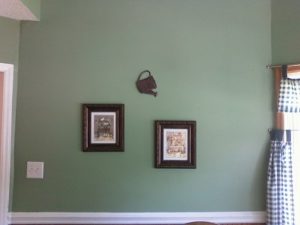Hanging Pictures | How To Create Mood and Beauty With Picture Frames and Artwork
Simplify the task of hanging picture frames. Follow these few straightforward rules and your hanging artwork will look terrific.
Think Eye Level
Hanging multiple picture frames begins by establishing a base centerline. This is a focal point that should be common to all pictures in the group. The principal centerline is based upon eye level contact with the center of the primary picture frame.
Purchase This Ariticle
764 words $22.92
[wp_cart:Article – Hanging Pictures | How To Create Mood And Beauty With Picture Frames And Artwork:price:22.92:end]
The following steps will help you establish a base centerline:
- Grasp a pencil between the index finger and middle finger of your primary hand.
- Ensure that the writing point protrudes two inches beyond the backside of your hand.
- Looking directly at the picture, grasp the frame near the middle, with one hand on each side of the outer edges.
- Stand near the horizontal center of the chosen wall.
- Hold the frame out and away from your body so that your hands are at eye level.
- Using the pencil, make a short vertical mark along the wall at the height of your hands.
- This is your central focal point and line for every picture.
Arrange Images To Establish Visual Power
All grouped artwork should have a central theme. This theme is established by a single, primary picture, document, or drawing. When hanging more than one picture, center your primary artwork to coincide with your central focal point on the selected wall.
Spacing Between The Frames
Improper spacing between the individual pieces of artwork can result in a distorted concept of the overall display. Take time to consider physical distances, color tones, and existing light shading. Collect and balance the following bits of information:
- Measure each individual frame or picture.
- Measure the available wall space.
- Remember the dangers of overcrowding any given area.
- For similar patterned artwork, a tight gap between the picture frames tends to look good.
- For unrelated works, increase the breathing space between the items. This adds an element of distinction to each piece.
- Also consider points of contact, the existing wall colors, and the tones within each piece of artwork. Dark colors typically work better with increased spacing.
Wall Selection
This may seem like a no-brainer, but wall selection is critical to safe picture placement within your home. Give careful consideration to all of the following details:
- Due to humidity and temperature issues, you should avoid mounting any picture frame on an exterior wall. Even in a well insulated home, the changes in external temperature can create some degree of continuous temperature variance on an external wall.
- Never hang your picture frames above an HVAC vent. This too is due to the presence of humidity and temperature changes.
- Likewise, consider the location of household activities such as cooking, washing, and showering. Steam or excess heat can cause severe damage to your favored artwork. Place your picture frames in an area that will always remain moisture free.
- High traffic areas can also be a risky choice for picture frame location, expressly if young children are in the home. Also consider the winter elements that can be associated with a constantly used exterior door.
- When dealing with portraits, avoid corner locations least the subject of the portrait develop a sense of isolation and rejection.
- Calculate the arrangement of the frames. Make sure that the accumulated size of the picture frames will fit within the selected wall area.
Presentation of the Images
You desire a satisfactory display of your cherished artwork. Imagine pictures as words. What concept do you wish to relay to the audience? What emotion do you wish to share with your friends? What is the history that you are speaking to yourself?
The grouping of the images must promote a desired effect. Presentation, position, and focus are all packed into the following choices:
- Lighting establishes mood and speculation.
- Balance reflects serenity, harmony, and individualism.
- Background enhances the meaning.
Hammers, Nails, and Screws
Save yourself a headache and a damaged wall. Before drilling, hammering, or punching, determine the arrangement of the artwork. Here are some common precautions:
- Precede physical holes with pencil marks and blue painter’s tape.
- If possible, create a sized pattern of the frame. To do this, lay the frame on a sheet of newspaper. Mark out the full size of the frame. Cut out the pattern. Use tape and the pattern to experiment with various layouts of the artwork.
- Consider resting the artwork on wall shelves or an easel.
- Never underestimate the weight of a picture frame. Always use appropriate anchors.
Storage
Perhaps you must pack some of your artwork. Long-term storage works best when the pictures are removed from the frames and stored in covered boxes. Yet even for short-term storage, you should make certain that your cherished images are not exposed to any extended heat or excessive light sources.













